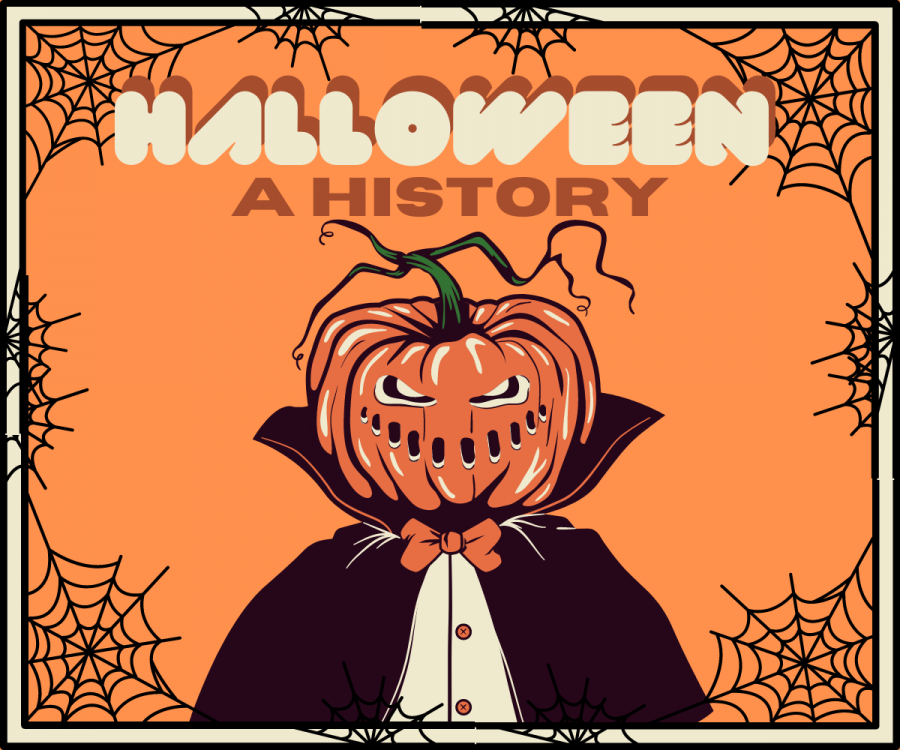Halloween: A History
The spooky holiday has rich historical past
Ever since the 900’s, Halloween has been a holiday filled with superstitions and linked to death. Since then, it has developed a rich history and developed into a wonderful day of self-expression and carved out pumpkins.
We know Halloween as a celebration to carve pumpkins, give out yummy treats, and dress up as our favorite pop culture characters. In reality, the annual charade of gorging on candy was not the original intention of Halloween.
During the 900s, Catholicism was rising in Europe. Celtic festivities, like Samhain, were still honored tradition, so the current pope decided the best way to keep converts coming was to create an annual holiday with a similar theme occurring at the same time: All Saint’s Day. It bounced through dates in May and early November and eventually the day before Nov. 1 became known as All Hallows’ Eve. This name was eventually shortened through time to our beloved Halloween.
Most European areas linked Hallows eve to a “day of the dead,” similarly to the Samhain tradition of communing with other-worldly spirits and honoring the deceased. People in the UK area often wore handmade costumes and masks as a means of receiving treats, personifying the dead that would go and “haunt” the houses they stopped at. This is also where the idea of trick-or-treating came from.
In the 1700s and 1800s, Halloween took on the personality of Valentine’s Day, women having a myriad of superstitions and traditions like bobbing for apples to see who would marry first. Even more strangely, women would look in the mirror of a dark room in hopes to see the face of her future husband.
At first, America was slow to join the bandwagon of Halloween due to the strict nature of Puritans, whose leisure time included nothing that resembled fun. In the mid-1800s, the Potato Famine occurred in Ireland, along with the Industrial Revolution. Catholic immigrants in search of work brought Halloween traditions to America, and it started to grow in popularity.
This is when the celebration of jack-o-lanterns started, people not only carving pumpkins, but also turnips, potatoes and beets. The term “jack-o–lantern” actually stems from Irish legend of “Stingy Jack” who had tricked Satan. Since he made Satan a deal to not damn him to hell, he could not go there when he died, nor could God let such a deceiving soul into heaven, he was sent out to live on Earth in the night, with only a carved-out turnip lantern lighting his path.
Associations of bats on Halloween came about in Nova Scotian mythology, where a bat inhabiting a home symbolized death coming to a member of the family.
When America reached the 20th century, Halloween really started to kick into high gear. Because Halloween had a new nature of mischief, vandalism and destruction of property was running rampant in cities. To combat these pranks gone out of control situations, Halloween trick-or-treating made a comeback and was advertised to kids, rather than previously being a more adult-centered celebration.
In the turn of the century, several of our beloved candy companies like Hershey’s, Milky Way and other commercial chocolates were being founded. In the ‘30s and ‘40s, most were given homemade treats of cookies, candies, and toys. With a rise of arrests and scares of poison in treats in the ‘60s, commercial chocolates became the more standard way to distribute out goodies.
Since the ‘70s, costumes and traditions were similar to how they are today. Costumes became an outlet for expression and was especially popular in marginalized groups like the LGBTQ+ community. Having a place to experiment with gender expression was huge, and the only time it was truly socially acceptable.
On average, Americans around the country spend a total of 2.6 billion dollars per year. Although it is not a national holiday, Halloween is one of the most popular holidays in America today.


